Joget DX vs Mendix: A Strategic Enterprise Comparison (2025)
Date
Sep 01, 25
Reading Time
8 Minutes
Category
Low-Code/No-Code Development
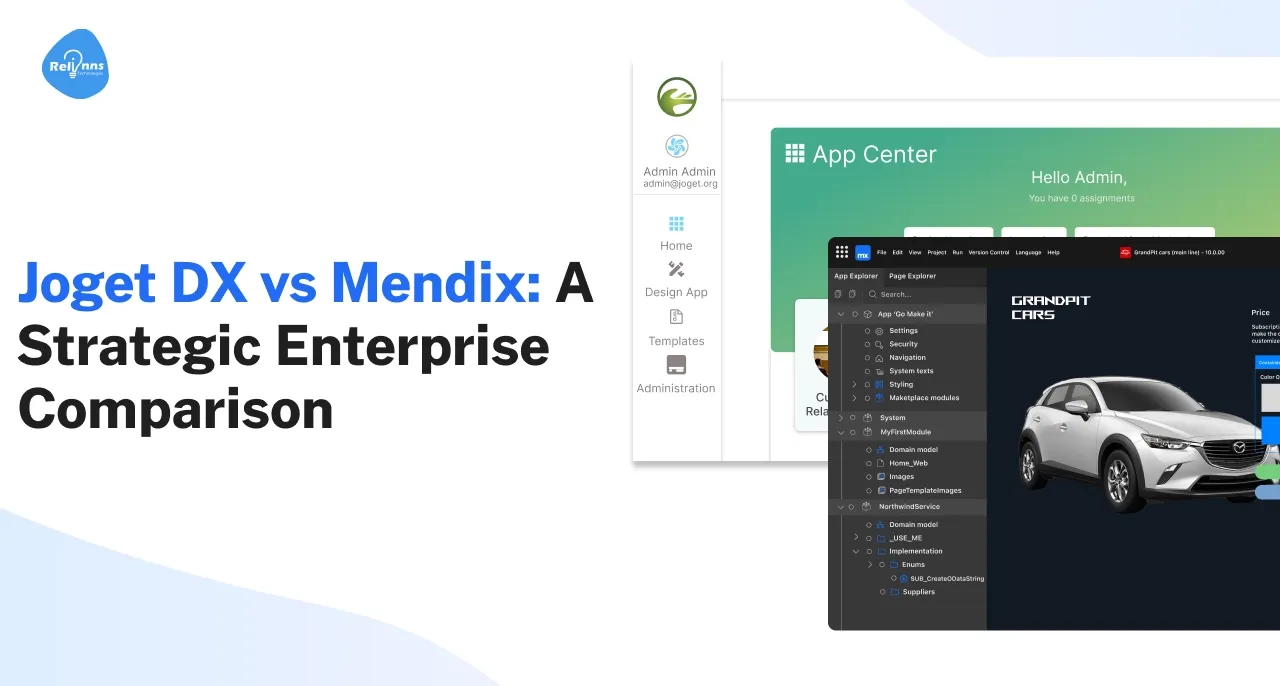
Enterprise leaders are building applications faster with low-code tools.
Gartner predicts that by 2025, 70% of new apps will use low-code/no-code. This growth is evident in Asia-Pacific (26.1% CAGR) and beyond.
A side-by-side Joget vs Mendix assessment is crucial for organizations planning large applications (ensuring the tech choice matches business needs).
Low-code adoption is global. Forrester notes ~60% of EMEA firms consider low-code critical. Joget and Mendix both target these markets: Joget’s presence spans North America, Europe, Middle East/Africa and Asia Pacific, while Mendix counts clients like the Municipality of Dubai.
This Joget and Mendix comparison will help B2B decision-makers weigh features, deployment options, and pricing for enterprise apps.
What is Joget DX?
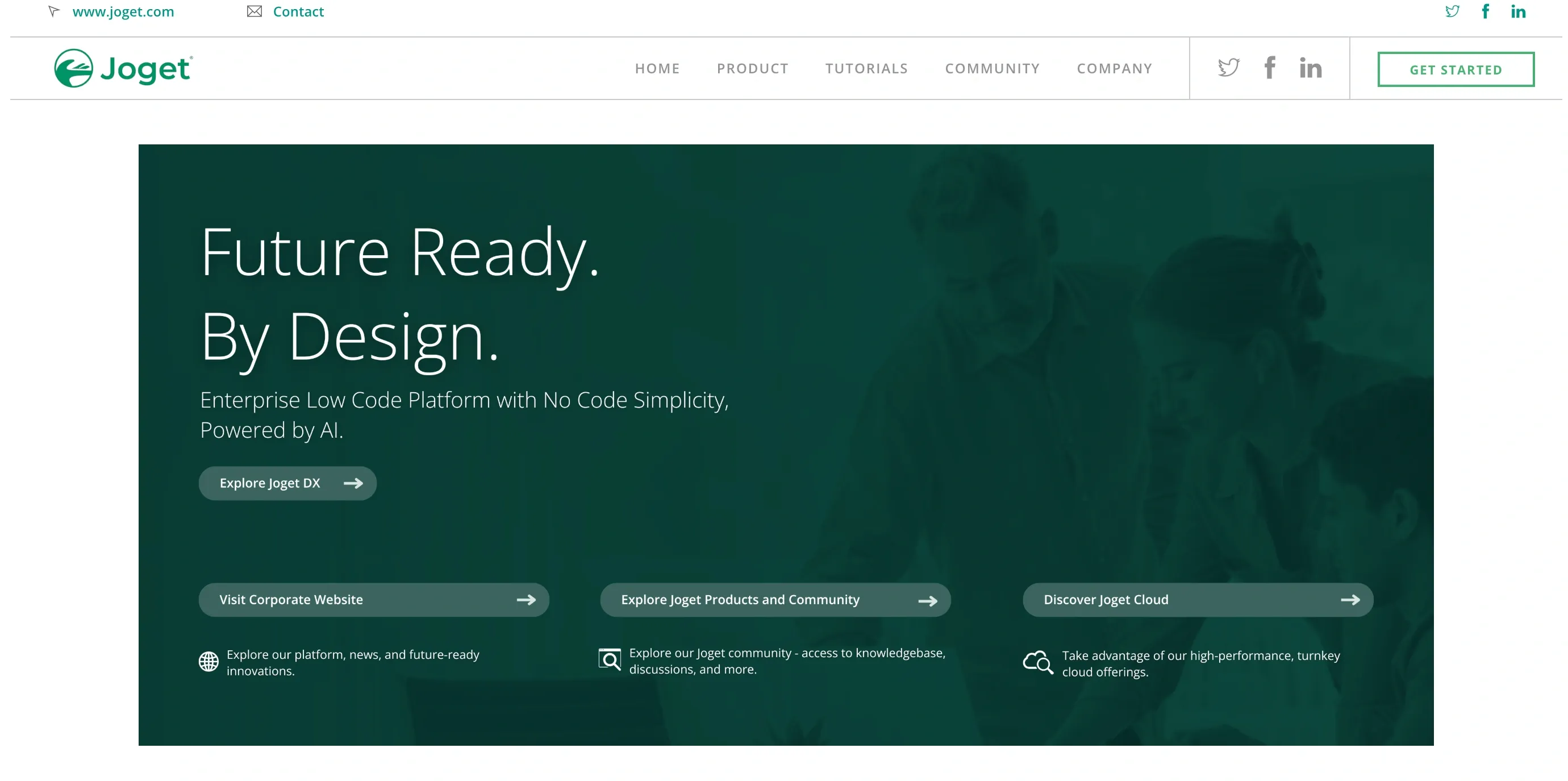
Joget DX is an open-source, low-code platform that simplifies the creation of enterprise applications.
It provides a visual development environment and a built-in workflow engine for rapid process automation. Teams can design forms, workflows, and dashboards with drag-and-drop builders.
Joget also supports REST APIs and mobile access, making it suitable for field service or invoice workflows.
What is Mendix?
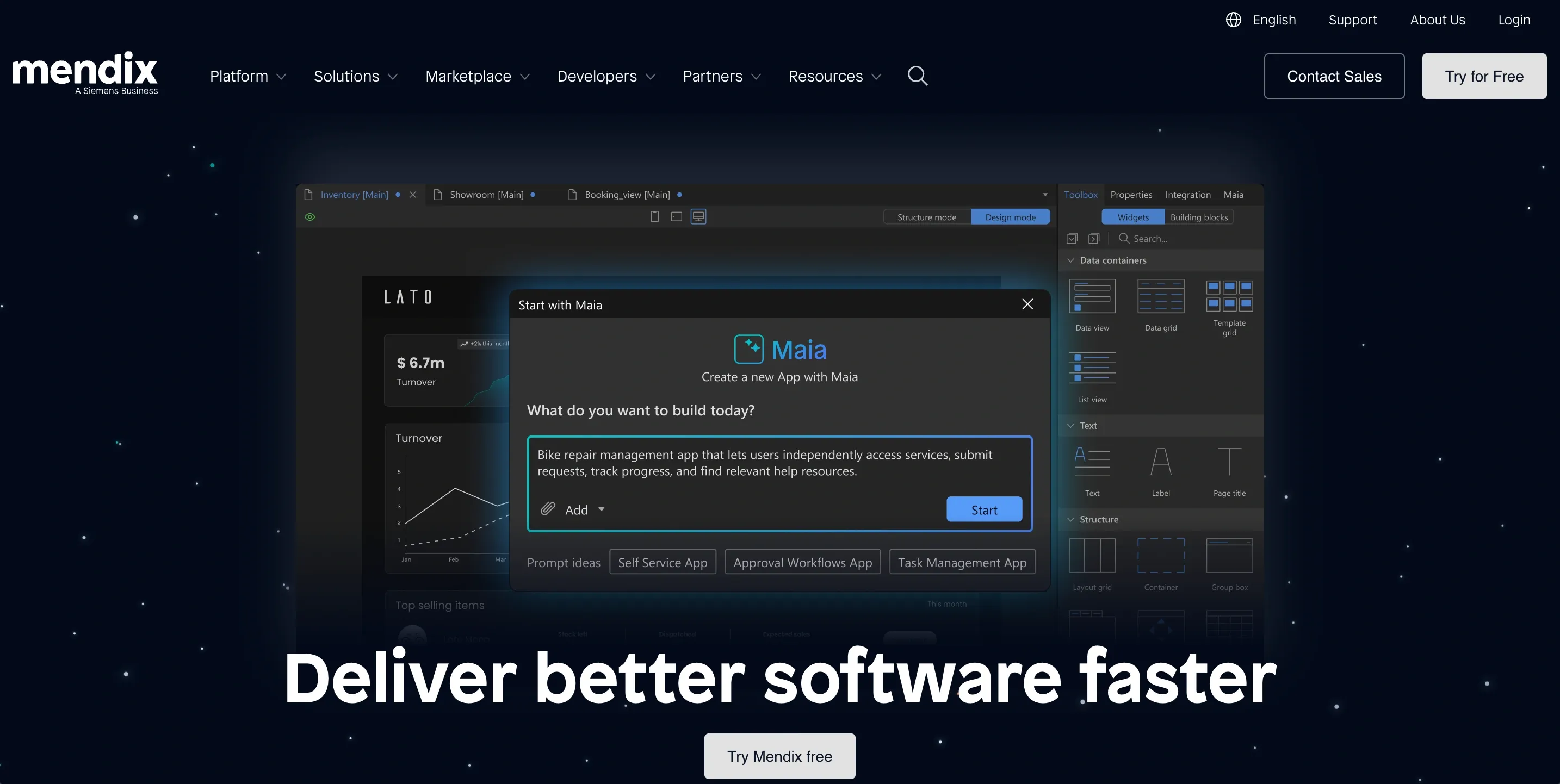
Mendix is a high-end enterprise low-code platform (by Siemens) for scalable applications.
It provides both a web-based Studio and a desktop Studio Pro for visual development.
Mendix supports microservices architecture and AI integrations, enabling complex digital transformation projects. It integrates with SAP, cloud services, IoT and can deploy to public clouds or private data centers.
App Development Features Comparison: Joget DX vs. Mendix
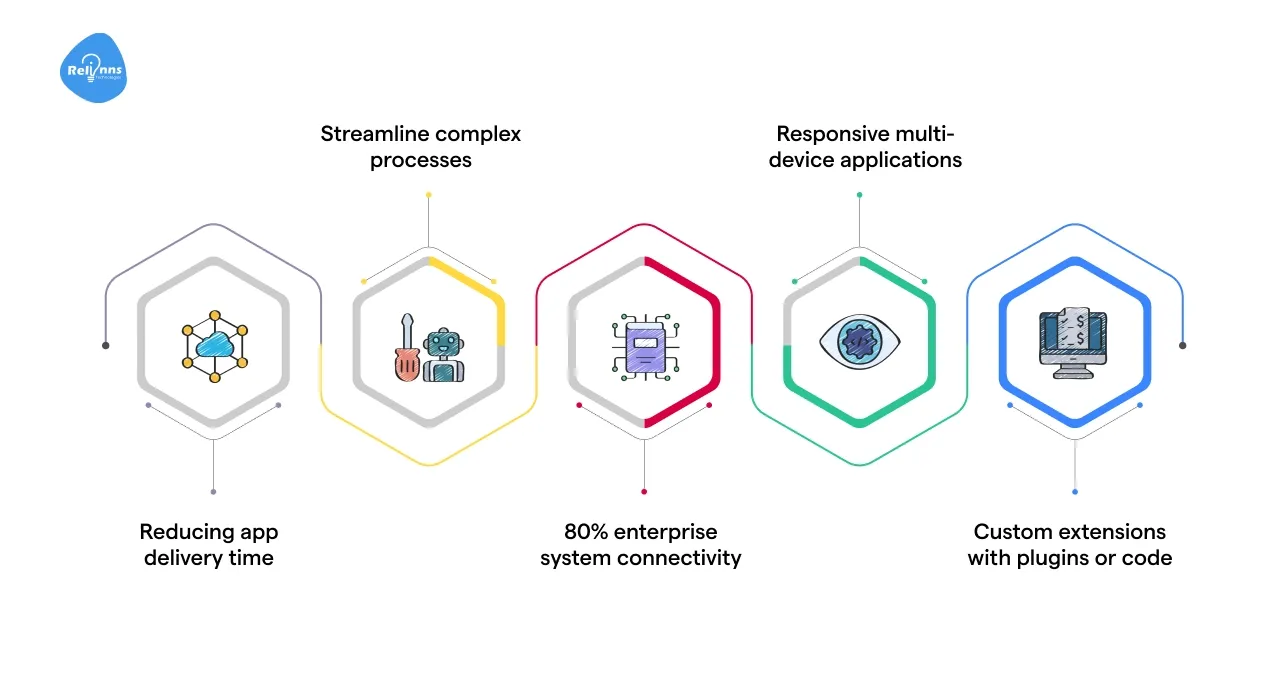
Both Joget and Mendix provide a rich toolbox of features.
They each deliver a visual development environment for drag-and-drop UI and workflow creation.
Joget’s builder emphasizes process automation, including form widgets, approval templates, and dashboards out of the box.
Mendix’s Studio Pro offers advanced widgets and model-driven development with code extensions.
Both platforms support REST and SOAP APIs for integration. Mendix has a broad marketplace of connectors (SAP, Salesforce, Epic, etc.), while Joget provides flexible database connectors and Java plugin APIs.
Despite their differences, these platforms share several essential similarities that make them competitive choices for modern enterprises.
Key Similarities
- Both provide a visual development environment, reducing app delivery time by up to 60%.
- Each includes integrated workflow automation tools that streamline complex processes for both business and IT teams.
- Both support REST and SOAP APIs, enabling over 80% enterprise system connectivity requirements.
- Each delivers responsive multi-device applications, ensuring mobile and web accessibility for end-users globally.
- Both allow custom extensions with plugins or code, enabling advanced customization when required.
Key Differences: Joget vs Mendix
Feature / Factor | Joget DX Highlights | Mendix Highlights |
| Deployment | Flexible on-premises deployment and cloud-native Kubernetes support | Cloud-native first, private cloud or on-premises with enterprise tiers |
| Target Users | Citizen developers and mid-sized organizations | Large enterprises with professional developer teams |
| Customization | Plugin-based Java extensions for workflows and apps | Full-stack extensions with Java, JavaScript, and APIs |
| Integration | REST/SOAP APIs, JDBC, and simple database connectors | Certified connectors for SAP, Salesforce, Azure, AWS |
| Pricing | Free Community edition; Enterprise ~ $13/user/month + $1000 set up free, minimum 100 users (Check out Joget pricing) | Free tier; Paid plan for 1 App starts at €900/month + add ons For unlimited apps, €2200/month + add ons (Check out Mendix Pricing) |
| Scalability | Manual cluster setup; effective for small-mid workloads | Built-in autoscaling, multi-region deployment, and high SLA guarantees |
| Ecosystem | Limited marketplace, open-source customization | Extensive marketplace with prebuilt connectors and templates |
| Compliance | ISO 27001, SOC 2 certified, PCI 3.2, FIMSA, & more | SOC2, GDPR, HIPAA, and industry-wide enterprise certifications |
| Best Fit | Budget-conscious teams seeking rapid process automation | Enterprises needing scalability, multi-cloud, and enterprise integrations |
Pros and Cons: Joget vs Mendix
Choosing between Joget vs Mendix means weighing trade-offs. Each platform has distinct strengths and limitations.
Pros and Cons of Joget DX Summary
When evaluating Joget vs Mendix, Joget DX demonstrates strong adoption among business users and delivers measurable productivity and cost benefits.
However, it still faces challenges with integrations, advanced AI features, and global ecosystem size.
Joget DX – Pros (Stat-Based) | Joget DX – Cons |
| 84% of enterprises report wider adoption by citizen developers | Smaller community compared to global enterprise rivals |
| Boosted productivity in 80% of organizations adopting low-code | Limited prebuilt connectors for complex system setups |
| Reduced operational costs in 79% of surveyed companies | Fewer advanced AI and automation features are available |
| Free community edition and cost-effective licensing tiers | Narrower marketplace and fewer enterprise templates |
Pros and Cons of Mendix Summary
In a Joget and Mendix comparison, Mendix clearly dominates enterprise adoption with a large ecosystem and faster delivery cycles.
Still, its higher licensing costs and learning curve remain barriers for smaller organizations and lean IT teams.
Mendix – Pros (Stat-Based) | Mendix – Cons |
| Holds ~15% market share in the global low-code market | Higher licensing and infrastructure costs for scaling |
| Adopted by 4,000+ enterprises with 300k+ active developers | Steeper learning curve for business-oriented builders |
| AI-assisted tools reduce app delivery time by ~40% | Increased complexity for small or mid-sized teams |
| Over 950,000 apps delivered across 46 countries | Dependence on vendor ecosystem for advanced features |
A. Scalability and Performance: Joget vs Mendix

Large enterprises expect high scalability.
Mendix is cloud-native: it offers automatic horizontal scaling, multi-region deployment and failover in higher tiers.
Joget can also scale (it supports containerized deployment and Kubernetes), but typically requires manual cluster setup.
Key Differences: Both platforms provide monitoring tools and support horizontal scaling, but their approaches differ (Mendix automated vs. Joget configurable).
Factor | Joget DX | Mendix |
| Scaling | Manual setup with Docker/Kubernetes | Auto-scaling with cloud-native architecture |
| Footprint | Strong for small and on-prem setups | Suited for multi-cloud enterprise workloads |
| Availability | Manual clustering and failover needed | Built-in failover and SLA-backed uptime |
| Monitoring | Basic monitoring, infra-dependent | Advanced monitoring with enterprise tools |
B. Integration and Extensibility: Joget and Mendix comparison
Integration is crucial in enterprise apps.
Joget provides built-in database connectors and cloud integrations, and its marketplace offers add-ons.
Mendix has many prebuilt connectors (SAP, Azure AD, AWS) and a large app store.
Key Differences: Both platforms provide strong API integration, but Joget is plugin-driven while Mendix offers certified connectors and an extensive marketplace.
Factor | Joget DX | Mendix |
| APIs & Connectors | REST/SOAP APIs with custom plugin flexibility | Certified connectors for SAP, Azure, AWS, others |
| Extensibility | Open-source allows unlimited code customization | SDK-based extensibility with vendor support |
| Data Sources | Works with JDBC, SQL, and NoSQL databases | Specialized support for SAP BTP and enterprise DB |
| Microservices | Workflows can invoke any external endpoints | Built-in support for external microservices calls |
C. Customization and Development Speed: Joget DX vs. Mendix
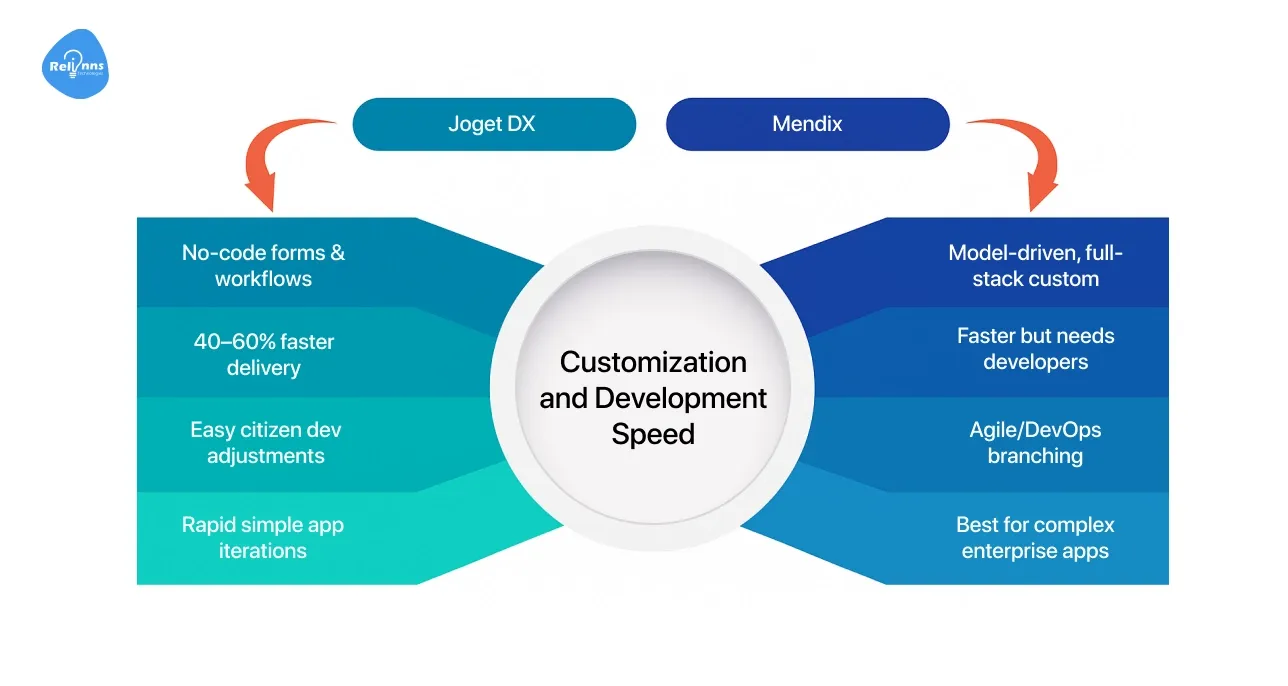
Speed and flexibility of development differ between the two platforms.
Joget vs Mendix comparisons often highlight Joget’s quick no-code prototyping versus Mendix’s full-stack customization and advanced team collaboration.
Key Differences: Joget delivers faster initial apps with no-code tools, while Mendix excels in complex, multi-department customizations.
Factor | Joget DX | Mendix |
| Development Style | No-code builder for forms, workflows, and rapid prototypes | Model-driven design with deeper full-stack customization |
| Speed | 40–60% faster app delivery than traditional development | Accelerated but often requires developer involvement |
| Agility | Easy adjustments by citizen developers during iterations | Advanced branching supports agile/DevOps but adds overhead |
| Best Fit | Faster delivery of simple, iterative applications | Strong for complex, multi-department enterprise solutions |
D. Security and Compliance: Joget vs Mendix
Enterprises demand high compliance and data security.
In the Joget vs Mendix comparison, both platforms deliver strong safeguards like encryption, audit trails, and private deployment options.
Key Differences: Both platforms meet enterprise security standards, but Mendix offers broader certifications and advanced DevOps security features.
Factor | Joget DX | Mendix |
| Certifications | ISO 27001, SOC 2, GDPR, HIPAA compliance options | SOC 2, GDPR, ISO, industry-specific certifications (finance, healthcare) |
| Access Control | Role-based access, audit logs, and encryption | Advanced identity management with SSO, OAuth, and MFA |
| Deployment Security | On-premises or cloud with data encryption and isolation | Cloud-native and private cloud with network isolation |
| DevOps Security | Basic testing and audit features | Secure pipelines, automated vulnerability testing, full compliance audits |
E. Support and Community: Joget vs Mendix
Community and vendor support differ.
Mendix has a large global community, extensive documentation, and 24/7 enterprise support options. It offers an online Academy, forums, and annual user conferences.
Joget’s community is smaller but active (forums, user groups). Joget provides professional support contracts as well.
Key Differences: Both platforms meet enterprise security standards, but Mendix offers broader certifications and advanced DevOps security features.
Factor | Joget DX | Mendix |
| Certifications | ISO 27001, SOC 2, GDPR, HIPAA options | SOC 2, GDPR, ISO, finance/healthcare focus |
| Access Control | RBAC, audit logs, encryption | SSO, OAuth, MFA, advanced identity features |
| Deployment | On-prem or cloud with data encryption | Cloud-native or private cloud with isolation |
| DevOps Security | Basic testing and audit tools | Secure pipelines and automated vulnerability checks |
Use Cases: Joget DX vs. Mendix
Both platforms span many industries.
Typical use cases include customer portals, case management, and mobile field apps.
Mendix is favored for large-scale transformation: digital government services, enterprise resource management, and IoT-driven solutions.
Joget often fits mid-size process automations: HR onboarding workflows, local government forms, or insurance claims portals.
A. Single Shenzhen Retailer Inventory Management — Joget DX Use Case
Problem: A UAE retailer struggled with stock inaccuracies and slow restocking cycles, leading to lost sales and inventory mismanagement across stores.
Solution: Relinns implemented a Joget DX–based inventory system that automated stock tracking, reconciled counts, alerted low inventory, centralized dashboards, and integrated warehouse workflows.
Results
- Achieved ~95% stock accuracy, reducing inventory errors and shrinkage significantly.
- Cut restocking cycle time by 40%, enabling faster replenishment and fewer stock-outs.
- Scaled across multiple stores within weeks, improving operational efficiency.
- Doubled inventory visibility across regions, reducing manual audits and discrepancies.
See more here: Relinns Inventory Management Case Study
B. Mendix Use Case: Raben Group Delivers 30+ Low-Code Apps in Logistics Transformation
Problem: Raben Group managed 16 million annual shipments across 15 countries using rigid, legacy tracking systems. Their fragmented, country-specific tools limited scalability, customized customer experience, and unified visibility—creating inefficiencies and slowing strategic digital transformation.
Solution: Using Mendix low-code, Raben developed 30+ Track and Trace and customer-facing apps, with deep integration across logistics systems, reusable UI components, governance frameworks, and rapid app delivery.
Results
- Delivered 30+ apps across logistics, enhancing governance and agility.
- Built the Track and Trace app in just 6 months, accelerating rollout.
- Achieved 100% data accuracy in the “myOrder” portal, improving customer trust.
- Processed 30,000 shipments daily through a unified digital interface.
See more here: Raben Group Mendix success story
Pricing Comparison: Joget vs Mendix
Both platforms offer free tiers and paid enterprise plans.
Mendix has a free plan, a Basic plan at €52.50 per user per month (single-app), and a Standard plan (~€900/month) for unlimited apps.
Joget DX has a free Community edition, and its Enterprise edition starts around $120/user/year. (Enterprise pricing is typically custom).
The table below summarizes key plan levels (visit the vendors’ pricing pages for details).
| Plan / Tier | Mendix (Monthly) | Joget DX (Annual) |
| Free | Free (unlimited apps/users) | Community Edition (GPL, free) |
| Basic / Standard | Standard: €900/month (one app) Unlimited apps starts from €2,100/month | Custom Pricing |
| Enterprise | Premium/Custom (quote required) | Custom enterprise pricing |
Which Tool is Best for Your App Development?
Ultimately, the best choice depends on your needs.
For complex, global projects with large teams and budgets, Mendix often wins: it offers robust scalability, extensive integrations, and enterprise support.
For smaller projects or tight budgets, Joget DX is compelling with its simplicity and low cost.
Consider deployment: Mendix excels in cloud or private cloud (and now offers AI-assisted development with Mendix Assist), while Joget equally supports on-premises deployment out of the box.
Evaluate your team’s skills and goals. In practice, many organizations conduct quick proofs-of-concept on both platforms to verify the best fit.
Also consider regional factors: Mendix has success with UAE and European enterprises, whereas Joget’s open model is popular in Asia-Pacific. Consulting experts can help align the choice with strategic goals.
Suggested Reading: Comparison of GeneXus vs Joget DX Enterprise
Final Thoughts on Joget vs Mendix for Enterprise Low-Code App Development
When evaluating Joget vs Mendix, the decision often comes down to project scale, budget, and long-term digital goals. Joget DX excels as a cost-effective, open-source solution for businesses seeking rapid automation and simple workflows.
Mendix, on the other hand, dominates in large-scale enterprise environments. With its cloud-native scalability, certified integrations, and enterprise-grade support, it is built for complex, multi-departmental applications that demand performance and resilience.
Both platforms deliver powerful visual development environments, but their strengths serve different audiences.
Why Choose Relinns for Joget?
- 90% of workflows need no coding, boosting development speed.
- 40% faster app deployment compared with top competitors.
- Workflow errors reduced by up to an impressive 75%.
- Compatible with 95% of enterprise collaboration and productivity tools.
- Workflow updates deploy 60% faster using visual no-code tools.
Why Choose Relinns for Mendix?
- 40% faster prototyping with agile Mendix development.
- 100% compliance with HIPAA, GDPR, PCI DSS, and SOC 2.
- Development costs reduced by up to 50% overall.
- Apps scale to support 3× more users seamlessly.
- 24/7 monitoring ensures reliable post-development support.
With Relinns, enterprises gain a trusted partner delivering 200+ apps worldwide, combining speed, scalability, and security in every solution.
Frequently Asked Questions (FAQ's)
Can Joget and Mendix easily integrate with legacy ERP systems?
Yes, both platforms support ERP integration. Joget connects via REST/SOAP APIs, while Mendix provides certified connectors for SAP, Oracle, and Microsoft, simplifying enterprise modernization projects.
Does Joget DX vs. Mendix support hybrid cloud environments?
Joget enables flexible on-premises deployment using Kubernetes, while Mendix provides multi-cloud deployment. Both allow hybrid setups, giving enterprises balance between scalability, security, and compliance requirements.
How does the visual development environment differ between Joget and Mendix?
Joget focuses on drag-and-drop simplicity for workflows and forms. Mendix’s visual development environment is more advanced, enabling model-driven design, branching, and custom coding for large-scale enterprise applications.
Which industries benefit the most from insights comparing Joget and Mendix?
Joget is ideal for SMEs needing automation and quick deployment. Mendix supports industries such as finance, healthcare, and manufacturing, where compliance, scalability, and deep integrations are crucial.
Can I migrate apps when switching from Joget to Mendix?
Direct migration is complex since Joget and Mendix have unique models. However, APIs and connectors allow interoperability, enabling the reuse of workflows, data models, and some UI elements.


